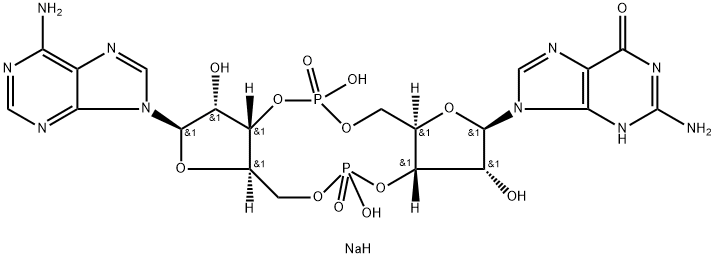
| 规格 | 价格 | 库存 | 数量 |
|---|---|---|---|
| 100μg |
|
||
| 500μg |
|
||
| 1mg |
|
||
| 5mg |
|
||
| 10mg |
|
||
| Other Sizes |

| 靶点 |
Endogenous Metabolite; second messenger; STING/stimulator of interferon genes
|
|---|---|
| 体外研究 (In Vitro) |
cGAMP 二钠刺激小鼠肿瘤细胞的发育[2]。在体外,人类和小鼠树突状细胞直接被 cGAMP 二钠激活 [2]。当用 cGAMP 二钠治疗时,患者成纤维细胞表现出 IFNB1 的转录增强,但产生肿瘤因子 (TNF)、白细胞介素 6 (IL6) 或白细胞介素 1 (IL1) 的基因的转录没有增强 [3]。内质网 (ER) 驻留蛋白 STING 被 cGAMP 二钠激活,从而诱导抗病毒状态和 I 型分离蛋白行走 [4]。
|
| 体内研究 (In Vivo) |
免疫小鼠的脾细胞被鼻粘膜佐剂 cGAMP 二钠 (5 μg) 刺激产生提示性细胞因子 [2]。
最近发现的哺乳动物酶环GMP-AMP合酶在被病原体来源的细胞质双链DNA激活后产生环GMP-cAMP(cGAMP)。该产品可以刺激STING依赖性干扰素I型信号传导。在这里,我们探讨了cGAMP作为小鼠粘膜佐剂的疗效。在这项研究中,研究人员表明,cGAMP可以增强对模型抗原卵清蛋白的适应性免疫反应。它促进免疫小鼠的抗原特异性IgG和平衡的Th1/Th2淋巴细胞反应。cGAMP诱导的免疫反应的一个特征是白细胞介素-17的诱导略有减少,这是Th17活性的标志,这是其他环核苷酸佐剂没有观察到的一个明显特征。我们进一步表征了小鼠骨髓来源的树突状细胞和人树突状细胞在体外的先天免疫刺激活性。观察到的结果表明,cGAMP可作为人类疫苗的候选粘膜佐剂[2]。 |
| 酶活实验 |
胞浆DNA诱导I型干扰素和其他细胞因子,这些细胞因子对抗菌防御很重要,但也可能导致自身免疫。这种DNA信号通路需要衔接蛋白STING和转录因子IRF3,但DNA传感的机制尚不清楚。我们发现,哺乳动物细胞质提取物在体外由三磷酸腺苷和鸟苷三磷酸在DNA而非RNA的存在下合成环鸟苷一磷酸腺苷一磷酸(环GMP-AMP或cGAMP)。哺乳动物细胞的DNA转染或DNA病毒感染也会触发cGAMP的产生。cGAMP与STING结合,导致IRF3的激活和干扰素-β的诱导。因此,cGAMP在后生动物中起着内源性第二信使的作用,并触发干扰素的产生以响应细胞质DNA[1]。
|
| 细胞实验 |
原代细胞的体外刺激[2]
原代细胞的培养基中补充了5µg/ml(小鼠细胞)或60µg/ml(人细胞)的c-di-AMP或cGAMP,或者不添加任何添加剂。细胞在37°C下孵育24小时。 Scrape loading[[3] HEK STING细胞以2.5×105个细胞ml-1的密度接种在96孔板中。16小时后,向培养基中加入cGAMP(2′-5′)至终浓度为50μg ml−1。使用18G针手动损伤单层细胞,每孔6处划痕。4-8小时后采集图像。 |
| 动物实验 |
Animal/Disease Models: Female C57BL/6 (H-2b) mice 6-8 weeks old [2]
Doses: 5 µg Route of Administration: Nostril mucosal adjuvant Experimental Results: Compared with serum from OVA-immunized mice, using cGAMP adjuvant Ovalbumin (OVA)-specific IgA and total IgG as well as IgG1 and IgG2c titers were higher in the serum of OVA-immunized mice. Mouse immunization experiments[2] Five animals per group were immunized i. n. on days 0, 14 and 28. Animals were anesthetized with Isoflurane and treated 10 µl per nostril with 15 µg OVA alone or co-administered with 5 µg per dose of c-di-AMP, cGAMP or cholera toxin B subunit in Ampuwa or with Ampuwa alone in the control group (mock immunization). On day 42 after immunization animals were sacrificed and samples were collected. |
| 参考文献 | |
| 其他信息 |
The innate immune defence of multicellular organisms against microbial pathogens requires cellular collaboration. Information exchange allowing immune cells to collaborate is generally attributed to soluble protein factors secreted by pathogen-sensing cells. Cytokines, such as type I interferons (IFNs), serve to alert non-infected cells to the possibility of pathogen challenge. Moreover, in conjunction with chemokines they can instruct specialized immune cells to contain and eradicate microbial infection. Several receptors and signalling pathways exist that couple pathogen sensing to the induction of cytokines, whereas cytosolic recognition of nucleic acids seems to be exquisitely important for the activation of type I IFNs, master regulators of antiviral immunity. Cytosolic DNA is sensed by the receptor cyclic GMP-AMP (cGAMP) synthase (cGAS), which catalyses the synthesis of the second messenger cGAMP(2'-5'). This molecule in turn activates the endoplasmic reticulum (ER)-resident receptor STING, thereby inducing an antiviral state and the secretion of type I IFNs. Here we find in murine and human cells that cGAS-synthesized cGAMP(2'-5') is transferred from producing cells to neighbouring cells through gap junctions, where it promotes STING activation and thus antiviral immunity independently of type I IFN signalling. In line with the limited cargo specificity of connexins, the proteins that assemble gap junction channels, most connexins tested were able to confer this bystander immunity, thus indicating a broad physiological relevance of this local immune collaboration. Collectively, these observations identify cGAS-triggered cGAMP(2'-5') transfer as a novel host strategy that serves to rapidly convey antiviral immunity in a transcription-independent, horizontal manner.[3]
|
| 分子式 |
C20H25N10NAO13P2
|
|---|---|
| 分子量 |
698.408995389938
|
| 精确质量 |
718.063
|
| CAS号 |
2407516-83-8
|
| 相关CAS号 |
cGAMP diammonium;cGAMP;849214-04-6
|
| PubChem CID |
137120249
|
| 外观&性状 |
White to off-white solid powder
|
| 来源 |
Endogenous Metabolite
|
| tPSA |
331
|
| 氢键供体(HBD)数目 |
5
|
| 氢键受体(HBA)数目 |
19
|
| 可旋转键数目(RBC) |
2
|
| 重原子数目 |
47
|
| 分子复杂度/Complexity |
1290
|
| 定义原子立体中心数目 |
8
|
| SMILES |
O[C@@H]1[C@]2([H])OP(OC[C@@]3([H])O[C@@H](N4C=NC5=C(N=CN=C45)N)[C@H](O)[C@]3([H])OP(O)(=O)OC[C@@]2([H])O[C@H]1N1C=NC2C(N=C(N)NC1=2)=O)(O)=O.[NaH]
|
| InChi Key |
MFPHQIYDBUVTRL-DQNSRKNCSA-L
|
| InChi Code |
InChI=1S/C20H24N10O13P2.2Na/c21-14-8-15(24-3-23-14)29(4-25-8)18-10(31)12-6(40-18)1-38-45(36,37)43-13-7(2-39-44(34,35)42-12)41-19(11(13)32)30-5-26-9-16(30)27-20(22)28-17(9)33;;/h3-7,10-13,18-19,31-32H,1-2H2,(H,34,35)(H,36,37)(H2,21,23,24)(H3,22,27,28,33);;/q;2*+1/p-2/t6-,7-,10-,11-,12-,13-,18-,19-;;/m1../s1
|
| 化学名 |
disodium;2-amino-9-[(1S,6R,8R,9R,10S,15R,17R,18R)-17-(6-aminopurin-9-yl)-9,18-dihydroxy-3,12-dioxido-3,12-dioxo-2,4,7,11,13,16-hexaoxa-3λ5,12λ5-diphosphatricyclo[13.3.0.06,10]octadecan-8-yl]-1H-purin-6-one
|
| 别名 |
Cyclic GMP-AMP; G14522; Cyclic GMP-AMP disodium;3',3'-cGAMP disodium
|
| HS Tariff Code |
2934.99.9001
|
| 存储方式 |
Powder -20°C 3 years 4°C 2 years In solvent -80°C 6 months -20°C 1 month 注意: 请将本产品存放在密封且受保护的环境中,避免吸湿/受潮。 |
| 运输条件 |
Room temperature (This product is stable at ambient temperature for a few days during ordinary shipping and time spent in Customs)
|
| 溶解度 (体外实验) |
H2O : ~180 mg/mL (~250.57 mM)
|
|---|---|
| 溶解度 (体内实验) |
配方 1 中的溶解度: 100 mg/mL (139.20 mM) in PBS (这些助溶剂从左到右依次添加,逐一添加), 澄清溶液; 超声助溶。
请根据您的实验动物和给药方式选择适当的溶解配方/方案: 1、请先配制澄清的储备液(如:用DMSO配置50 或 100 mg/mL母液(储备液)); 2、取适量母液,按从左到右的顺序依次添加助溶剂,澄清后再加入下一助溶剂。以 下列配方为例说明 (注意此配方只用于说明,并不一定代表此产品 的实际溶解配方): 10% DMSO → 40% PEG300 → 5% Tween-80 → 45% ddH2O (或 saline); 假设最终工作液的体积为 1 mL, 浓度为5 mg/mL: 取 100 μL 50 mg/mL 的澄清 DMSO 储备液加到 400 μL PEG300 中,混合均匀/澄清;向上述体系中加入50 μL Tween-80,混合均匀/澄清;然后继续加入450 μL ddH2O (或 saline)定容至 1 mL; 3、溶剂前显示的百分比是指该溶剂在最终溶液/工作液中的体积所占比例; 4、 如产品在配制过程中出现沉淀/析出,可通过加热(≤50℃)或超声的方式助溶; 5、为保证最佳实验结果,工作液请现配现用! 6、如不确定怎么将母液配置成体内动物实验的工作液,请查看说明书或联系我们; 7、 以上所有助溶剂都可在 Invivochem.cn网站购买。 |
| 制备储备液 | 1 mg | 5 mg | 10 mg | |
| 1 mM | 1.4318 mL | 7.1591 mL | 14.3182 mL | |
| 5 mM | 0.2864 mL | 1.4318 mL | 2.8636 mL | |
| 10 mM | 0.1432 mL | 0.7159 mL | 1.4318 mL |
1、根据实验需要选择合适的溶剂配制储备液 (母液):对于大多数产品,InvivoChem推荐用DMSO配置母液 (比如:5、10、20mM或者10、20、50 mg/mL浓度),个别水溶性高的产品可直接溶于水。产品在DMSO 、水或其他溶剂中的具体溶解度详见上”溶解度 (体外)”部分;
2、如果您找不到您想要的溶解度信息,或者很难将产品溶解在溶液中,请联系我们;
3、建议使用下列计算器进行相关计算(摩尔浓度计算器、稀释计算器、分子量计算器、重组计算器等);
4、母液配好之后,将其分装到常规用量,并储存在-20°C或-80°C,尽量减少反复冻融循环。
计算结果:
工作液浓度: mg/mL;
DMSO母液配制方法: mg 药物溶于 μL DMSO溶液(母液浓度 mg/mL)。如该浓度超过该批次药物DMSO溶解度,请首先与我们联系。
体内配方配制方法:取 μL DMSO母液,加入 μL PEG300,混匀澄清后加入μL Tween 80,混匀澄清后加入 μL ddH2O,混匀澄清。
(1) 请确保溶液澄清之后,再加入下一种溶剂 (助溶剂) 。可利用涡旋、超声或水浴加热等方法助溶;
(2) 一定要按顺序加入溶剂 (助溶剂) 。